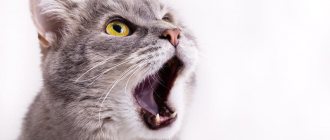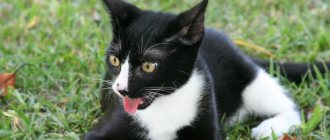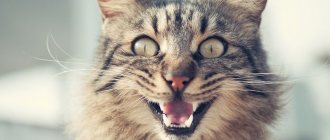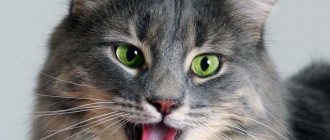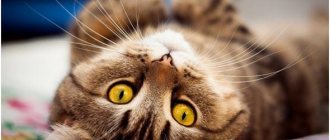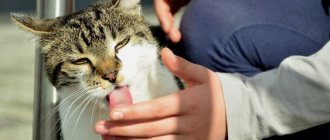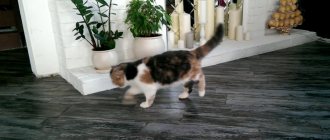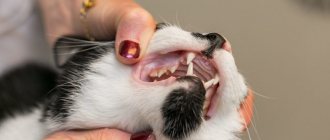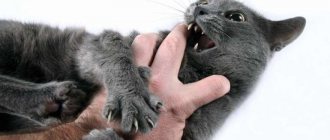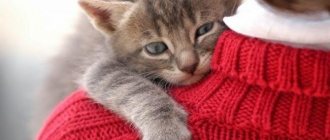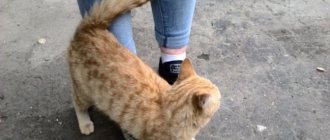At rest, a cat inhales and exhales approximately 30 times per minute, that is, every two seconds. The norm for cats is from 20 to 40 breaths per minute, for kittens - up to 50 breaths. If a cat frequently breathes for more than 15 minutes, this can be caused by both benign physiological reasons and serious life-threatening illnesses for which the animal needs emergency care. The owner of a pet should be aware of what can cause rapid breathing in a cat, when it should be considered dangerous, and what actions should be taken to prevent serious consequences.
Pets breathing is normal
The respiratory process of mustachioed pets is similar to that of humans. When you inhale, air enters the nose and travels through the respiratory tract to the lungs. The carbon dioxide remaining after processing is removed along a similar route, but in reverse order.
An adult cat takes 20-40 breaths per minute, and a kitten takes 40-50. The breathing of a healthy animal is practically not audible, but its presence can be determined by the evenly and smoothly descending pectoral muscles.
Breathing Features of Cats
The breathing process of a cat is not fundamentally different from other mammals, including humans. When an animal breathes, air is drawn in through the nose, enters the larynx, and from there through the trachea is sent to the lungs. Next, oxygen is picked up by the blood and distributed to all organs of the body. "Waste" goes back along the same path:
- lungs;
- trachea;
- larynx;
- nasal passages.
In a calm state, a cat breathes approximately 30 times per minute, that is, every two seconds. The norm is the number of breaths from 20 to 40. In kittens this figure is slightly different and can reach 50 times.
Rapid breathing in adult cats is observed when they are frightened, excited, or angry about something. For example, while traveling in public transport, meeting a dog or during active games. You can also notice that the pet is breathing frequently and its stomach is heaving if the cat is very hot.
Another reason for deviation is the female’s prenatal condition or estrus. All these situations can be considered a variant of the norm. Very little time passes, the cat calms down and breathes as usual again. However, sometimes we are talking about deviations.
Why is a cat breathing heavily and frequently: non-dangerous reasons
Tachypnea, or rapid, heavy breathing, occurs in a cat when there is a lack of oxygen, or hypoxia. This condition is explained by 2 reasons: physiological and pathological.
Physiological causes are not life-threatening. These include various external and internal factors:
- Heat. A pet can overheat outside on a hot day or in a stuffy room with poor ventilation.
- Eating food quickly. Characteristic in the absence of saturation and prolonged fasting. Due to the too rapid absorption of food, breaths are taken in fits and starts, so the oxygen supplied with them is not enough.
- Fatigue after high physical activity. When performing intense movements, muscles require more oxygen, which is why shortness of breath often occurs while running.
- Overexcitement due to fear or aggression. In a state of stress, the body actively produces adrenaline, which speeds up the heart and the frequency of breathing. After calming down, the alarming symptoms disappear on their own.
- Hormonal changes. Occurs during estrus, pregnancy and childbirth. Treatment in these cases is not required, provided that the rest of the condition remains normal.
The risk group includes older cats and overweight cats. They get tired faster and often suffer from obesity due to inactivity.
General preventive recommendations
Since there can be many causes of respiratory problems in cats, preventive measures boil down to maintaining the good physical condition of the animal. If the body has high resistance, the cat gets sick much less often and becomes more resilient. In addition, the cat is less likely to develop any hereditary diseases.
It is necessary to ensure that the animal does not overheat in the summer, do not overload it beyond measure, and do not overfeed it. It is very good if, from childhood, the kitten is surrounded by a calm, friendly environment.
Heavy breathing in cats and cats is an alarming sign
With pathological causes, the problem lies in internal disorders, fraught with life-threatening complications. The cat is not only breathing heavily with its stomach, but it also looks unwell. The danger of the condition can be determined by the accompanying symptoms.
The main signs that a cat is suffocating
Suffocation caused by lack of oxygen is difficult to miss. It is accompanied by the following symptoms:
- shortness of breath;
- rapid heartbeat;
- general weakness;
- wheezing and sniffling;
- tachycardia;
- cough.
Most often, breathing problems occur in brachycephalic cats, that is, breeds with a flat face. Due to the specific structure of the skull, their nasal passages are narrower and shorter. Such animals inhale a more limited air flow throughout their lives and are much more susceptible to diseases affecting the respiratory tract.
Associated symptoms
In case of health problems, accompanying symptoms are added to the main symptoms. They depend on the cause of the ailment:
- Infectious diseases of the respiratory system (tracheitis, pneumonia, bronchitis). Lack of air occurs due to the active production of leukocytes, which clog the airways in the form of mucus. In addition to discharge from the eyes and nose, gastrointestinal upset (diarrhea, vomiting) and fever are noted.
- Injuries to the spine, ribs and respiratory system. The resulting fragments pinch the lungs, preventing them from fully opening. The cat experiences severe pain when touched or on a constant basis. With internal bleeding, blood comes out along with phlegm.
- Entry of a foreign body into the respiratory tract. Swallowing or inhaling foreign objects is accompanied by severe coughing, sneezing, salivation and lacrimation. Vomiting is also possible.
- Lungworms. These parasites lead to coughing, sneezing and internal bleeding.
- Neoplasms of various nature. Tumors in the respiratory tract interfere with the natural circulation of oxygen. The animal often coughs, wheezes and swallows saliva with effort. In the presence of oncology, there is an increase in sleep time, general weakness, weight loss and deterioration in coat quality.
- Cardiovascular diseases. The circulation of oxygen through the bloodstream occurs thanks to the heart, so any disruption in its functioning leads to difficulty breathing. From a lack of oxygen, the skin turns white and the mucous membranes turn blue. In severe cases of the disease, foam sometimes comes out of the mouth, and the cat itself may lose consciousness.
- Pulmonary edema. Develops as a result of injuries, heart pathologies, kidney and liver diseases. Accompanied by apathy, refusal to eat, blanching of the mucous membranes and noisy gurgling inside the chest.
- Poisoning. The body gets rid of toxins through vomiting and diarrhea. If strong poisons are swallowed, convulsions and pulse disturbances are possible.
Due to the overlap of some symptoms, making an accurate diagnosis on your own is very problematic. Without timely treatment, all of the diseases described above can lead to death from hypoxia, so if you suspect a pathology, it is better to immediately contact a veterinarian.
Asthma in pets
Another possible cause of periodic asthma attacks is asthma. It is easily recognized by a lingering cough. During the next exacerbation, the animal crouches to the floor and stretches its neck. This position is very similar to regurgitation of hairballs, so the disease is often ignored in the initial stages.
In most cases, the source of feline asthma remains unknown. Because of this, animals have to take medications on an ongoing basis. Glucocorticosteroids are most often used to suppress hypersensitivity of the upper respiratory tract.
Types of shortness of breath
It is possible to determine that a cat is suffering from shortness of breath.
The main features are:
- the appearance of specific whistling and wheezing sounds;
- the cat gasps for air with its mouth open, but the exhalation does not occur fully;
- the animal takes an uncharacteristic (forced) pose, tries to lie down, but begins to choke;
- breathing is not carried out in a natural way for a cat - through the mouth (this provokes pallor of the mucous membranes of the oral cavity and its dryness), cyanosis is noted.
Depending on the disease that provoked shortness of breath, there are several types:
- rare breathing – bradypnea. This type occurs when the functional characteristics of certain centers located in the brain are insufficient;
- rapid breathing - tachypnea, characterized by shallow inhalations and exhalations that occur during pathological blood conditions and febrile conditions.
The shortness of breath phase also has its own definition, so they distinguish:
- inspiration - heavy inhalation and normal exhalation;
- expiration - heavy exhalation and normal inhalation;
- mixed shortness of breath - characterized by heavy inhalation and exhalation.
How to provide first aid to a choking pet
First aid methods depend on the cause of the illness. In case of short-term disturbance, breathing often normalizes on its own, but in case of long-term disturbance, followed by cardiac arrest, the animal may require artificial respiration and indirect massage.
Basic steps
For physiological reasons, the pet simply needs to be given time to catch its breath and calm down. If overheating is to blame, be sure to offer a bowl of water and cool the areas where large vessels pass (neck, inner thighs, groin) with a cold compress. It is also recommended to open all doors and windows to create a draft.
If the cat is breathing heavily and wheezing, carefully examine his throat and check the integrity of the ribs. If you find a foreign body or injury, go to the veterinary clinic immediately. Self-help can result in accidentally pushing the found bone or other object even deeper, so it’s better not to take risks here.
Thus, the main actions are limited to normalizing body temperature, ventilating the room and calming the animal. The only exception is sudden cardiac arrest, as well as poisoning, provided its cause is known.
Is it possible to do artificial respiration?
If a cat loses consciousness and does not respond to light, then it requires urgent resuscitation. The rescue operation must begin within 2-3 minutes after the heart has stopped. In such a critical situation, it is very important not to panic, immediately call a veterinarian at home, and then strictly follow the following algorithm:
- Place the animal on its right side and extend its neck in line with the body. This will facilitate air flow.
- Clean the oral cavity from accumulated secretions with a napkin or gauze and close the mouth tightly. Removing mucus will help your pet avoid choking once breathing returns to normal.
- Inhale more air, place your curled palm on the cat’s nose and gently exhale into his nostrils. The frequency of inhalations depends on the size of the animal. With average settings, 20 times per minute is enough. The kitten will need more frequent but less intense repetitions.
- Check your pulse every 20 seconds. When breathing stops, the heart temporarily continues its work, so indirect massage is not required in all cases. If the heartbeat has really stopped, move on to the next step.
- Place one hand on the cat's chest, holding it between the thumb and the other four fingers.
- Perform several quick and rhythmic pressing movements with a break of 5 seconds, remembering to alternate them with artificial respiration. For every 30 movements there should be 2 breaths.
If possible, the rescue operation is best carried out in pairs. Once the heartbeat resumes, the animal cannot be moved, so at this point you just need to wait for the veterinarian.
Professional help
If a cat with rapid breathing is examined by a veterinarian, then first of all, the owner of the mustachioed creature should be told about the possible causes of the problem and, together with the veterinarian, exclude physiological factors. After a thorough examination of the pet, the veterinarian will work according to the following scheme:
- determine the temperature of a sick mustache, which will help confirm or exclude the infectious nature of the disease;
- will give directions for biochemical and clinical blood tests - necessary to detect anemia, diabetes or infections;
- will detect the presence of worms in the tail (if any);
- to exclude tumors in the chest area, problems with the heart and peritoneum, the doctor will give a referral for an ultrasound and x-ray;
- in particularly severe situations, thoracentesis may be required, when the chest wall is pierced, which helps to identify the presence of excess air or fluid in the organs;
In case of injuries and oncological development of the disease, in most cases surgical intervention is necessary. In other situations, drug therapy is prescribed, which directly depends on the diagnosis made by a specialist.
In a state of shock (rapid drop in blood pressure), the pet needs to quickly restore its respiratory rhythm, which is done with the help of adrenaline therapy, infusion therapy, various diuretics, corticosteroids, and analgesics.
When is a vet visit necessary?
If you have certain symptoms, it is better not to waste time on self-examination. These include:
- rapid deterioration of the condition or lack of improvement within 3 hours;
- severe wheezing and gurgling in the chest;
- the appearance of pain when touching or coughing, accompanied by a plaintive meow;
- copious discharge of mucus from the nose or mouth;
- pale or blue discoloration of the skin and mucous membranes;
- increase or decrease in heart rate;
- convulsions;
- loss of consciousness.
Particular attention should be paid to children, elderly and pregnant animals. If the kitten is breathing heavily, then it should be taken to the veterinary clinic even in the absence of the listed symptoms. Due to fragile immunity, pets often get sick with complications up to a year old, so in such a situation it is better to play it safe.
In addition to visual inspection and palpation (palpation), a blood test, ultrasound, x-ray and ECG may be required to make a diagnosis. The list of medications will depend on the pathology found:
- antibiotics and antivirals that fight infectious agents;
- anthelmintics that destroy parasites;
- cardiotonics and vasopressors, which reduce the volume of circulating blood and increase the force of heart contraction;
- diuretics, facilitating the removal of excess fluid;
- glucocorticosteroids, eliminating allergies and inflammatory processes;
- sorbents that stimulate the removal of toxins.
In case of poisoning, an antidote may be required. Surgery is used when injuries, deep-lying foreign bodies and neoplasms are detected. If at the time of treatment the cat is in serious condition, then it can be placed in an oxygen chamber.
Reasons to urgently consult a doctor
A cat's breathing itself is often not always a cause for panic. As noted above, the animal could get scared, angry, tired during outdoor games, etc.
Various chronic or infectious diseases that the owner knows about can cause such a symptom, then the cat is simply treated with methods previously prescribed by the doctor. However, there are accompanying signs when you need to take your pet to the clinic urgently :
- rapid or too weak pulse;
- change in color of mucous membranes (red, blue, white shades);
- severe wheezing or gurgling in the chest;
- copious amounts of fluid coming from the mouth or nasal passages.
Also, you should not hesitate if the indicated symptoms are absent, but the owner does not even imagine why his cat may often breathe from his stomach. The sooner a doctor makes a diagnosis, the higher the chances of a favorable outcome.
